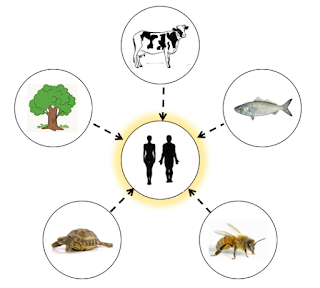Framing for care and engagement (Part IV): Nature is kin
By Rodrigo Cáceres
In Part III of this post, we talked about strategies for undermining, discrediting and abandoning the frame of "Nature is a collection of resources" due to its intrinsic antagonism with a respect and appreciation for life on Earth. We also discovered an alternative frame: "Nature is our child", performed by a local community in India. This frame evokes nature in loving, protecting and caring terms. It also conceives a reciprocal, respectful and enduring relationship with nature, in a subject to subject exchange, highlighting nature's vitality, agency and its striving for existence.
Another alternative frame that you may be familiar with is "Nature is our mother" that is used commonly through the notions of Pachamama, Ñuke Mapu, Mother Earth or Mother Nature. This frame is embodied by several indigenous cultures in Latin America (for example, Quechua, Mapuche, Aymara); and by First Nations in North America. This frame also evokes nature as close family, as one's mother who allowed for our existence, towards who one has a duty of respect, care and protection. In a general sense, in both of these frames that purport "Nature as kin" (child and mother), the emotional dimension of these relations with nature becomes a basic element for the constitution of social reality.
Let me explain the last thing I said. The main point is that there is an intimately link between frames and the constitution of social reality. By social reality I mean the totality of cultural practices that define a human community in its singularity. This includes (i) practices such as language, music, rituals, food cultivation, social roles, power distribution, social norms and institutions. It includes also (ii) a collective imaginary that includes ideas about what the world is, which elements conform it; what is human and what is our role and purpose of existence; how should we relate to other living beings, and so on. The part (i) of the definition is also referred to as a cosmopraxis, and the part (ii) as a cosmology. Naturally, the cosmology of a culture is inextricably linked with its cosmopraxis.
As we saw in Part II of this post, when we look at reality through the frame of "Nature is a collection of resources", a lot of practices become acceptable and meaningful, such as building dams, farming monocultures, constructing mega-industrial projects including mining in Australia and Latin America, tar sands in Canada, industrial logging in the Amazon, among others.
In general, most of the cultural practices of modernity embody these values, namely that nature is an object (that is separated from humans) and that is to be exploited for obtaining raw materials to be used at humans' will. Nowadays, this frame intimately relates to a collective imaginary about the existence of "the economy" as an autonomous entity that must be driven towards growth and reproduction, ultimately to insure, maintain and increase individuals' material richness (Escobar, 2018).
Contrarily, all of the practices of modern cultures I just mentioned make no sense at all when we look reality through the frame of "Nature is family", they become absurd and opposed to reason. Family must be respected and protected, not exploited, destroyed and sold.
Going back to our example of the local community in India, Neera Singh documented how this community reconstituted their social reality as a consequence of adopting the frame of "the forest is family". The community redefined itself as the "forest-caregivers" (jungle surakhayari), and they also created songs and narratives that expressed bonds to the forest as child, mother and friend. This is also revealed in personal convictions, as the following testimony of the local women: ‘‘We would protect the forest as we would protect our own child from any danger.’’ (Singh, 2013, p.194). Their social reconstitution also embodies a radically different conception of work from the one present in modern cultures. For the "forest-caregivers", patrolling the forest and protecting it to favor its regeneration is seen as an embodied work that is done with authentic intention and emotion, for the purpose of developing a relationship with the forest and benefiting from its landscape, its shadow, the microclimate it creates, as well as its wood and food.
References
Escobar, A. (2018). Sentir-penser avec la terre. Le Seuil.
Singh, N. M. (2013). The affective labor of growing forests and the becoming of environmental subjects: Rethinking environmentality in Odisha, India. Geoforum, 47, 189-198.
Let me explain the last thing I said. The main point is that there is an intimately link between frames and the constitution of social reality. By social reality I mean the totality of cultural practices that define a human community in its singularity. This includes (i) practices such as language, music, rituals, food cultivation, social roles, power distribution, social norms and institutions. It includes also (ii) a collective imaginary that includes ideas about what the world is, which elements conform it; what is human and what is our role and purpose of existence; how should we relate to other living beings, and so on. The part (i) of the definition is also referred to as a cosmopraxis, and the part (ii) as a cosmology. Naturally, the cosmology of a culture is inextricably linked with its cosmopraxis.
As we saw in Part II of this post, when we look at reality through the frame of "Nature is a collection of resources", a lot of practices become acceptable and meaningful, such as building dams, farming monocultures, constructing mega-industrial projects including mining in Australia and Latin America, tar sands in Canada, industrial logging in the Amazon, among others.
In general, most of the cultural practices of modernity embody these values, namely that nature is an object (that is separated from humans) and that is to be exploited for obtaining raw materials to be used at humans' will. Nowadays, this frame intimately relates to a collective imaginary about the existence of "the economy" as an autonomous entity that must be driven towards growth and reproduction, ultimately to insure, maintain and increase individuals' material richness (Escobar, 2018).
Contrarily, all of the practices of modern cultures I just mentioned make no sense at all when we look reality through the frame of "Nature is family", they become absurd and opposed to reason. Family must be respected and protected, not exploited, destroyed and sold.
Going back to our example of the local community in India, Neera Singh documented how this community reconstituted their social reality as a consequence of adopting the frame of "the forest is family". The community redefined itself as the "forest-caregivers" (jungle surakhayari), and they also created songs and narratives that expressed bonds to the forest as child, mother and friend. This is also revealed in personal convictions, as the following testimony of the local women: ‘‘We would protect the forest as we would protect our own child from any danger.’’ (Singh, 2013, p.194). Their social reconstitution also embodies a radically different conception of work from the one present in modern cultures. For the "forest-caregivers", patrolling the forest and protecting it to favor its regeneration is seen as an embodied work that is done with authentic intention and emotion, for the purpose of developing a relationship with the forest and benefiting from its landscape, its shadow, the microclimate it creates, as well as its wood and food.
References
Singh, N. M. (2013). The affective labor of growing forests and the becoming of environmental subjects: Rethinking environmentality in Odisha, India. Geoforum, 47, 189-198.





Comments
Post a Comment